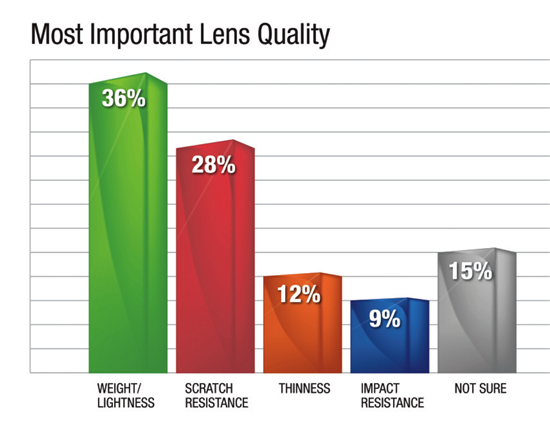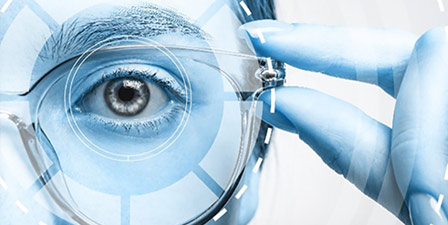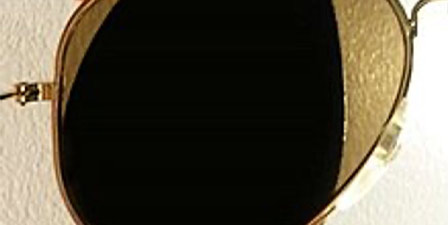 |
A lens' final thinness, a major patient benefit, is determined not only by index, but more importantly, by the material's impact resistance (for the frame style, size and shape chosen by the patient).
The extreme impact strength of Trivex material significantly exceeds FDA impact requirements. This allows minus lenses with thinner centers to be sold. Unlike lenses made with CR-39 monomer (from PPG Industries), which are produced to 2.0mm centers, lenses made with Trivex material are produced to about 1.2mm centers. This 0.8mm reduction in thickness is possible in all but the powers near plano. In addition, that also means an equal reduction in edge thickness of almost a millimeter. When combined with the index of 1.53, lenses are thinner yet. In plus lenses, edges can be made thinner, since the material is not prone to flaking or chipping (due to tensile strength, notch sensitivity) especially when grooved.
This benefit of lens thinness is typically combined with lightness in the sales process. That's because thinness reduces lens volume and creates the final weight of the lens. However, the real lens weight is a function of volume and the material's specific gravity. In this case, Trivex material was engineered to be the lightest material (1.11g/cm3). In the same Rxs, lenses with Trivex material are always thinner and lighter than CR-39 monomer due to its index, extreme impact resistance and specific gravity.
Patient Benefit—Thin and Light: When compared to CR-39 monomer, lenses made with Trivex material are up to 15 to 20 percent thinner and always about a third lighter. An aspheric design will further reduce thickness and weight. While there are other higher index materials that can make lenses even thinner, lightness depends on final lens volume and its specific gravity. Some high-index materials have much higher specific gravities so the weight savings when compared to Trivex material is less than you might think. While the highest index lens of equal power is another 15 to 20 percent thinner, within the core range, lenses made with Trivex material are still 10 percent lighter. For the core range of lens prescriptions (-4.00 to +3.00), having a lighter lens is always a selling benefit.

VisionWatch patient surveys report that patients value the lightness of their eyewear the most.
Patient Benefit—Clear Vision: Material choice also affects the clarity of vision. A lens' clarity is a product of Abbe, glare-free (anti-reflective) coating and the type of lens design used. Prism, off-center in prescription lenses, creates power errors and blur, the result of chromatic aberration and the lens design. Manufacturers work hard to create lens designs that reduce off-center power errors but the material still contributes clarity based on its abbe. The higher the abbe, the less chromatic blur. The result is a larger, clearer field-of-view (for the same prescription, material-to-material). CR-39 material and glass lenses have the best Abbe. To support a choice of Trivex material as a replacement for CR-39 material, lens clarity should be equivalent. After all, crisp vision is an expectation of your patients, not something that you sell as an added benefit. Abbe values are a relative measure of clarity and are not linear. Trivex material has an Abbe value of 45 which produces lens clarity virtually equivalent to CR-39 material.
Patient Benefit—Protection: The protective qualities of eyewear are an everyday benefit that is seldom discussed unless the subject is children's eyewear or sports lenses. The protection provided by eyewear should be a discussion every time eyewear is sold. Lenses can provide a shield against the damage from ultraviolet (UV) radiation and protect the eyes from impact from random accidents.
Patient Benefit—UV Protection: UV radiation is a recognized contributor to the formation of cataracts. As a result, lenses sold in eyewear should always provide 100 percent UV protection. Any choice for an everyday lens material must provide 100 percent UV protection. CR-39 monomer, depending on specific lens manufacturer processes, absorbs between 85 to 90 percent of UV radiation while Trivex material provides 100 percent UV protection.
While a UV dye can be applied to CR-39 material for added absorption, this dye can compromise the long term adhesion of anti-reflective coatings and result in delamination. Therefore, it is more practical to choose a material that provides 100 percent UV protection without additional processing. Every lens made with Trivex material automatically provides protection from the effects of UVA and UVB radiation.
Patient Benefit—Impact Protection:According to The Bureau of Labor Statistics (BLS), almost 70 percent of the eye injuries studied occurred from falling or flying objects, or sparks striking the eye. The best way to prevent eye injuries is to always wear the appropriate eye protection. Since no one can predict when they will need eye protection, it makes sense to have eyewear, even everyday glasses that provide impact resistance at all times. While it may be easier to bring up the subject of impact resistance when talking about kids' eyewear or sports specific eyewear, the truth is that everyone needs to protect their eyes and their vision, all the time.
By providing patients with an everyday lens that offers extreme impact resistance, you are making sure that their eyes receive the best protection no matter the activity. Providing this protection is even more important today, when patients are less likely to purchase more than one pair of glasses due to financial reasons. This means they are more likely to wear their everyday glasses while playing sports, working in the yard or around the house. Lenses made with Trivex material have 62-times the impact resistance of ordinary plastic lenses.
One office uses this statement to get across the message of eye protection for everyday lenses: "Our office recommends Trivex material as our standard lens material of choice because it provides the visual armor to protect your eyes from both UV light, while providing the ultimate in impact resistance, no matter what you are doing."













